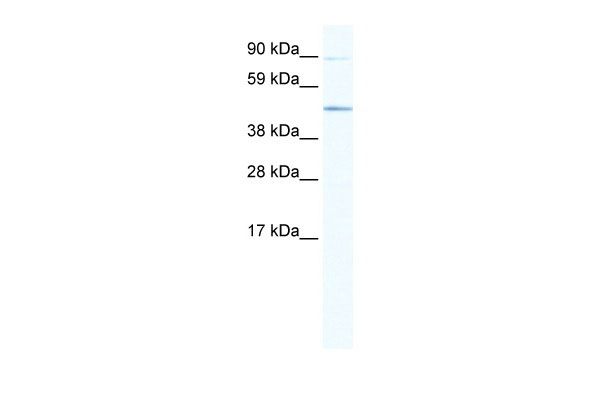SITPEC antibody - middle region
Rabbit Polyclonal Antibody
- SPECIFICATION
- CITATIONS
- PROTOCOLS
- BACKGROUND

Application
| WB |
|---|---|
| Primary Accession | Q9QZH6 |
| Other Accession | NM_012029, NP_036159 |
| Reactivity | Human, Mouse, Rat, Rabbit, Horse, Bovine, Dog |
| Predicted | Human, Rat, Bovine |
| Host | Rabbit |
| Clonality | Polyclonal |
| Calculated MW | 48kDa |
| Gene ID | 26940 |
|---|---|
| Alias Symbol | Sitpec |
| Other Names | Evolutionarily conserved signaling intermediate in Toll pathway, mitochondrial, Protein SITPEC, Ecsit, Sitpec |
| Format | Liquid. Purified antibody supplied in 1x PBS buffer with 0.09% (w/v) sodium azide and 2% sucrose. |
| Reconstitution & Storage | Add 100 ul of distilled water. Final anti-SITPEC antibody concentration is 1 mg/ml in PBS buffer with 2% sucrose. For longer periods of storage, store at 20°C. Avoid repeat freeze-thaw cycles. |
| Precautions | SITPEC antibody - middle region is for research use only and not for use in diagnostic or therapeutic procedures. |
| Name | Ecsit {ECO:0000312|MGI:MGI:1349469} |
|---|---|
| Synonyms | Sitpec |
| Function | Adapter protein that plays a role in different signaling pathways including TLRs and IL-1 pathways or innate antiviral induction signaling (PubMed:10465784). Plays a role in the activation of NF- kappa-B by forming a signal complex with TRAF6 and TAK1/MAP3K7 to activate TAK1/MAP3K7 leading to activation of IKKs. Once ubiquitinated, interacts with the dissociated RELA and NFKB1 proteins and translocates to the nucleus where it induces NF-kappa-B-dependent gene expression. Plays a role in innate antiviral immune response by bridging the pattern recognition receptors RIGI and MDA5/IFIT1 to the MAVS complex at the mitochondrion (By similarity). Promotes proteolytic activation of MAP3K1. Involved in the BMP signaling pathway (PubMed:14633973). Required for normal embryonic development (By similarity). |
| Cellular Location | Cytoplasm {ECO:0000250|UniProtKB:Q9BQ95}. Nucleus {ECO:0000250|UniProtKB:Q9BQ95}. Mitochondrion {ECO:0000250|UniProtKB:Q9BQ95} |
| Tissue Location | Detected in heart, brain, lung, liver, skeletal muscle, kidney and testis. Detected in embryonic mesoderm and epiblast, and in extraembryonic ectoderm. |

Thousands of laboratories across the world have published research that depended on the performance of antibodies from Abcepta to advance their research. Check out links to articles that cite our products in major peer-reviewed journals, organized by research category.
info@abcepta.com, and receive a free "I Love Antibodies" mug.
Provided below are standard protocols that you may find useful for product applications.
References
Xiao,C., et al., (2003) Genes Dev. 17 (23), 2933-2949Reconstitution and Storage:For short term use, store at 2-8C up to 1 week. For long term storage, store at -20C in small aliquots to prevent freeze-thaw cycles.
If you have used an Abcepta product and would like to share how it has performed, please click on the "Submit Review" button and provide the requested information. Our staff will examine and post your review and contact you if needed.
If you have any additional inquiries please email technical services at tech@abcepta.com.













 Foundational characteristics of cancer include proliferation, angiogenesis, migration, evasion of apoptosis, and cellular immortality. Find key markers for these cellular processes and antibodies to detect them.
Foundational characteristics of cancer include proliferation, angiogenesis, migration, evasion of apoptosis, and cellular immortality. Find key markers for these cellular processes and antibodies to detect them. The SUMOplot™ Analysis Program predicts and scores sumoylation sites in your protein. SUMOylation is a post-translational modification involved in various cellular processes, such as nuclear-cytosolic transport, transcriptional regulation, apoptosis, protein stability, response to stress, and progression through the cell cycle.
The SUMOplot™ Analysis Program predicts and scores sumoylation sites in your protein. SUMOylation is a post-translational modification involved in various cellular processes, such as nuclear-cytosolic transport, transcriptional regulation, apoptosis, protein stability, response to stress, and progression through the cell cycle. The Autophagy Receptor Motif Plotter predicts and scores autophagy receptor binding sites in your protein. Identifying proteins connected to this pathway is critical to understanding the role of autophagy in physiological as well as pathological processes such as development, differentiation, neurodegenerative diseases, stress, infection, and cancer.
The Autophagy Receptor Motif Plotter predicts and scores autophagy receptor binding sites in your protein. Identifying proteins connected to this pathway is critical to understanding the role of autophagy in physiological as well as pathological processes such as development, differentiation, neurodegenerative diseases, stress, infection, and cancer.


